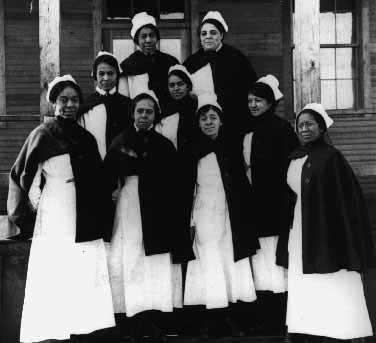


Click Images for Info


Mary Eliza Mahoney,R.N.
First Black Nurse 1845-1926
| "
The representation of minority nurses among the total nurse population increased from 7 percent in 1980 to 12 percent in 2000. Despite these increases, the diversity of the RN population remains far less than that of the general population where minority representation was more than 30 percent in 2000. (See Chart 6)...Growth in the number of African American/Black and Hispanic/Latino nurses in the years between 1996 and 2000 was greater than during any other four-year period between 1980 and 2000. The largest relative increase was among Hispanic/Latino nurses, with a 35.3 percent increase followed by African American/Black nurses with an increase of 23.7 percent. Hispanics, despite showing the largest relative increase between 1996 and 2000 remain the most underrepresented group of nurses when compared with the representation of Hispanics in the population. Only 2 percent of the RN population are Hispanic nurses although Hispanics comprise 12.5 percent of the general population.."Survey, put oin link "In March 2000, an estimated 86.6 percent
of the RN population reported being white (non-Hispanic), while 12.3 percent
reported being in one or more of the identified racial and ethnic minority
groups. An additional 1.1 percent of the respondents chose not to report
their racial and ethnic background. In 1996, an estimated 10.3 percent
reported being in one of the racial/ethnic minority groups identified.
|
| "Minorities make up about 25 percent
of the U.S. population, but only about 10 percent work as healthcare professionals.
Many believe that disparity is hurting access to health care for minorities,
and that the gap is bound to widen as the nation becomes more ethnically
diverse in the next decade"
Closing the Gap By Mary Ann Hellinghausen. Nurseweek.com March 13, 2000 "The percentage of minority RNs is increasing,
but at a very slow rate, and the percentage of minority RNs within
the RN population still lags behind the percentage of minorities within
the general population."
|
Registered Nurse Population
* 2,558,874 Licensed in the USA * 90% Caucasian * 4.2% African/American * 3.4% Asian/Pacific Islanders * 1.6% Hispanic * .5% American Indian/Alaskan Native Registered Nurse Statistics FACT SHEET From the American Association of Critical Care Nurses Webpages |
 |
|
| Below: Group Image: 1918, Camp Sherman, Chillicothe, Ohio. Members of the Army Nurse Corps . Part of the Crile Archives and History Education pages property of the Crile Archives and Cuyahoga Community College | |
 |
 |
Mahoney's Image from Duke University Medical Center Website:
Black History Month A Medical Perspective Exhibited February-March 1999
See also Bridgewater State College Hall of Black Achievement
National Association of Black Nurses
African American Women Nurses guide to print and web resources
Black Women In The Military[much info on nurses]
Erase the Hate: The Truth About Racism in Nursing
MinorityNurse.com
Link to their articles
index

National Digital Archive, African American Odyssey